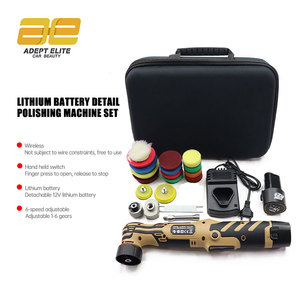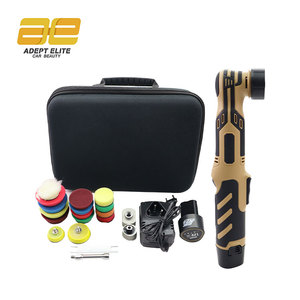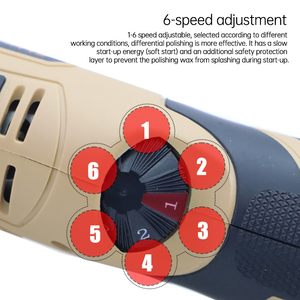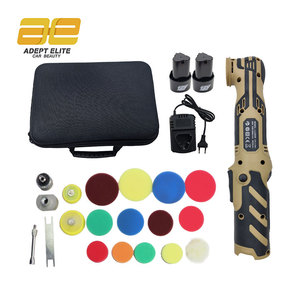(790 products available)


















































































































































































































A forced rotation dual action polisher, also known as a DA polisher, is a power tool used in automotive detailing and paint correction. The machine's head contains a pad that oscillates and rotates simultaneously. This allows the polisher to cover the paint surface more effectively, improving its shine and gloss. There are two main types of forced rotation dual-action polishers:
Regular or Non-Forced Dual Action Polishers
The standard dual-action polisher is a popular tool in the detailing industry. It uses a throwing motion that mimics hand polishing. The pad on the polisher is attached to an orbiting central section. As the central section orbits, it causes the attached pad to move in a circular pattern while simultaneously oscillating. This unique motion ensures that the polisher glides across the paint surface without any detrimental pressure or digging. The non-forced dual-action polishers are preferred for delicate paint finishes. They are also relatively affordable, making them popular among DIY detailers and professional detailers.
Forced Rotation Dual Action Polishers
Unlike the standard dual-action polisher, the pads on the forced rotation dual-action polishers are not connected to the orbiting section. Instead, they are directly linked to the drive motor. This unique feature ensures that the pad follows the motion of the motor at a constant speed. The forced rotation polishers offer more consistent results, especially when applying waxes and polishes. The key advantage of the forced rotation dual-action polisher is its ability to maintain a steady working speed on the product being applied to the paint surface. As a result, detailers can achieve a more uniform application.
Various specifications of forced rotation dual action polishers are available to meet distinct business needs. The key specifications include;
Power
When it comes to polishers, the power rating is essential. It is because power influences the intensity of the polishing action and the ability to remove imperfections. Forced rotation dual-action polishers come in different wattages. The wattage ranges from 350 watts to 900 watts. With high wattage, the polisher generates more power. As a result, it has more vigorous and consistent oscillation.
Orbit Size
The orbit size on a forced rotation dual action polisher is the distance the pad travels from the center. It is because the orbit size determines the coverage area and the aggressiveness of the action. Typically, the orbit size of the forced rotation dual-action polishers ranges from 8mm to 25mm.
Speed Settings
Speed settings are essential specifications in forced rotation dual action polishers. It is because the polishers come with different tasks and materials. Therefore, different tasks require distinct speeds for effective results. Usually, the polishers have multiple speed settings. The settings range from 1 to 6 or 1 to 8. This allows operators to customize the speed based on the specific requirements.
Weight
Weight is another important specification of forced rotation dual action polishers. Heavier units tend to be more stable during the polishing process. On the other hand, lighter units offer better maneuverability. Therefore, finding a balance between stability and maneuverability is essential. The weight of the forced rotation dual action polishers ranges from 1.5kg to 3.5kg.
Ergonomics
Considerations such as handle placement, vibration reduction, and grip comfort are essential in forced rotation dual action polishers. The polishers are designed to enable comfortable and secure operation. This ensures better control and reduces fatigue during polishing tasks.
Regular maintenance of forced rotation dual action polishers is crucial in ensuring optimal performance and prolonging lifespan. Here are some key maintenance tips for forced rotation dual action polishers.
Cleaning
It is important to clean the polishers regularly after each use. This prevents dust, product residue, and debris from accumulating. When cleaning, pay attention to the exterior, pads, and motors of the polishers. Use a damp cloth to wipe the exterior of the polishers. Also, inspect and remove any trapped debris or residue in the pads.
Inspect and Replace Worn Parts
Regularly inspect the polishers for signs of wear. For example, check the pads, backing plates, and motors for damage. In case of worn parts, replace them promptly. This will maintain the efficiency of the polishers.
Lubrication
Forced rotation dual action polishers have moving parts that require regular lubrication. Use the manufacturer's recommended lubricant when lubricating the moving parts. Follow the recommended intervals when lubricating the moving parts.
Tighten Fasteners
Over time, the fasteners of the polishers may come loose due to vibration during the operation of the polishers. Therefore, periodically, check and tighten all the fasteners. This prevents accidental detachment of parts.
Storage
Store the polishers in a clean and dry area away from direct sunlight and moisture. Ensure the polishers are not exposed to harsh chemicals or extreme temperatures. Proper storage prevents damage and maintains the performance of the polishers.
Wholesale buyers need to consider several factors when sourcing forced rotation dual action polishers. They include the following.
Power
Buyers should consider the power of the polishers they intend to purchase. The wattage or amperage of the polishers determines their power. Those with higher power are more suitable for heavy-duty polishing tasks. Additionally, forced rotation dual action polishers come with different motor power ratings. Buyers should select the polishers with motor power ratings that suit their target market.
Speed Control
Buyers should consider the speed control features of the polishers. Forced rotation dual action polishers come with variable speed settings or consistent speed settings. Those with variable speed settings allow users to have more control over the polishing process. Additionally, buyers should select polishers with speed settings that are suitable for the applications they intend to use.
Ergonomics
Buyers should consider the weight of the polishers and their handle design. It is advisable to purchase polishers with lightweight designs and comfortable handles. Such forced rotation dual action polishers prevent user fatigue and ensure a secure grip.
Power Source
Buyers should consider the power source of the polishers. Some polishers are powered by batteries, while others are powered by electricity. Forced rotation dual action polishers powered by batteries offer more convenience and mobility. On the other hand, polishers powered by electricity provide consistent power.
Accessories and Pads
Buyers should consider the compatibility of the polishers with different accessories and pads. Additionally, they should check if the polishers come with polishing pads and backing plates. Some polishers may not come with accessories.
Durability
Buyers should consider the durability of the polishers. The construction materials of the polishers give buyers an insight into their durability. It is advisable to purchase forced rotation dual action polishers that are made from durable materials.
Noise Level
Buyers should consider the noise level of the polishers. Those with noise reduction features are suitable for applications that require a quiet environment.
Polisher Size and Weight
Forcing rotation dual-action polishers come in various sizes and weights. Heavier and larger ones are suitable for big cars or industrial applications. However, smaller and lightweight polishers are appropriate for detailed work and small cars.
It is often very difficult to repair a forced dual action polisher, and because of this, manufacturers often provide guidelines on how to replace the polisher if it gets damaged.
Some of the steps that might be taken to replace a forced rotation dual action polisher are as follows:
Check Warranty:
Users should check if the polisher is still under warranty. If it is, they should reach out to the manufacturer for guidance on how to replace it.
Identifying Model:
Users should identify the model number of the damaged polisher, and this will help them get the exact parts needed to replace the polisher.
Disassembly:
Once the warranty period has elapsed, and the user decides to take action by themselves, they should carefully disassemble the unit to understand the internal mechanics.
Acquire Replacement Parts:
Users should order the replacement parts from the manufacturer or a licensed service provider to ensure they are compatible with the original device.
Assembly:
Once the replacement parts are obtained, users should follow the manufacturer's manual to reassemble the polisher.
Q1: Can the forced rotation dual action polisher be used on delicate paints?
A1: Yes, the forced rotation dual action polisher can be used on delicate paints. When working with delicate paints, users should select softer pads and less abrasive polishes. They should also use lower speed settings to minimize the risk of paint damage.
Q2: How often should the pads be replaced on a forced rotation dual action polisher?
A2: The frequency of pad replacement on a forced rotation dual action polisher can vary depending on usage and condition. As a general guideline, users should inspect pads after each use and replace them if they show significant wear, damage, or reduced performance.
Q3: Is training required to use a forced rotation dual action polisher effectively?
A3: While training is not always mandatory, it can be beneficial to learn proper techniques, product recommendations, and equipment handling. Many manufacturers and detailing academies offer training programs that cover all aspects of using polishers effectively and safely.
Q4: Can beginners use the forced rotation dual action polisher, or is it only for professionals?
A4: Beginners can use a forced rotation dual action polisher. Its user-friendly design makes it suitable for enthusiasts as well as professionals. With proper guidance, practice, and adherence to safety measures, anyone can achieve polishing and detailing results using this tool.
Q5: Is the forced rotation dual action polisher suitable for both cutting and finishing stages?
A5: Yes, the forced rotation dual action polisher is suitable for cutting and finishing stages. By changing the pads and compounds accordingly, users can achieve aggressive cut (if needed) or fine finishing, making the tool versatile for various detailing requirements.